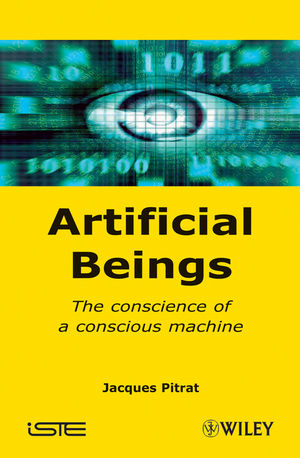Artificial Beings: The Conscience of a Conscious MachineISBN: 978-1-84821-101-8
Hardcover
256 pages
June 2009, Wiley-ISTE
 |
||||||
Acknowledgements ix
Note on the Terminology xi
Chapter 1. Presenting the Actors 1
1.1. The book 1
1.2. Human and artificial beings 4
1.3. The computer 7
1.4. The author 9
1.5. CAIA, an artificial AI scientist 11
1.6. The research domains of CAIA 15
1.7. Further reading 19
Chapter 2. Consciousness and Conscience 21
2.1. Several meanings of “consciousness” 22
2.2. Extending the meaning of “conscience” for artificial beings 25
2.3. Why is it useful to build conscious artificial beings with a conscience? 29
2.4. Towards an artificial cognition 31
2.4.1. A new kind of consciousness 32
2.4.2. A new kind of conscience 33
Chapter 3. What Does “Itself” Mean for an Artificial Being? 35
3.1. Various versions of an individual 36
3.1.1. The concept of an individual for human beings 36
3.1.2. The boundaries of an artificial being 39
3.1.3. Passive and active versions of an individual 41
3.1.4. Reflexivity 47
3.2. Variants of an individual 49
3.2.1. An individual changes with time 50
3.2.2. Learning by comparing two variants 50
3.2.3. Genetic algorithms 52
3.2.4. The bootstrap 54
3.3. Cloning artificial beings 57
3.3.1. Cloning an artificial being is easy 57
3.3.2. Cloning artificial beings is useful 58
3.4. Dr. Jekyll and Mr. Hyde 61
3.5. The Society of Mind 63
3.6. More on the subject 65
Chapter 4. Some Aspects of Consciousness 67
4.1. Six aspects of consciousness 68
4.1.1. One is in an active state 68
4.1.2. One knows what one is doing 72
4.1.3. One examines his/its internal state 80
4.1.4. One knows what one knows 84
4.1.5. One has a model of oneself 87
4.1.6. One knows that one is different from the other individuals 90
4.2. Some limits of consciousness 92
4.2.1. Some limits of consciousness for man 93
4.2.2. Some limits of consciousness for artificial beings 100
Chapter 5. Why is Auto-observation Useful? 105
5.1. Auto-observation while carrying out a task 105
5.1.1. To guide toward the solution 106
5.1.2. To avoid dangerous situations 111
5.1.3. To detect mistakes 121
5.1.4. To find where one has been clumsy 125
5.1.5. To generate a trace 126
5.2. Auto-observation after the completion of a task 129
5.2.1. Creation of an explanation 130
5.2.2. Using an explanation 133
5.2.3. Finding anomalies 138
Chapter 6. How to Observe Oneself 143
6.1. Interpreting 146
6.2. Adding supplementary orders 150
6.3. Using timed interruptions 154
6.4. Using the interruptions made by the operating system 158
6.5. Knowing its own state 159
6.6. Examining its own knowledge 160
6.7. The agents of the Society of Mind. 165
6.8. The attention 166
6.9. What is “I” 169
Chapter 7. The Conscience 173
7.1. The conscience of human beings 174
7.2. The conscience of an artificial being 179
7.3. Laws for artificial beings 183
7.3.1. Asimov’s laws of robotics 183
7.3.1. How can moral laws be implemented? 184
7.3.3. The present situation 191
Chapter 8. Implementing a Conscience 195
8.1. Why is a conscience helpful? 197
8.1.1. The conscience helps to solve problems 197
8.1.2. The conscience helps to manage its life 198
8.1.3. Two ways to define moral knowledge 199
8.1.4. Who benefits from the conscience of an artificial being? 200
8.2. The conscience of CAIA. 201
8.3. Implicit principles 202
8.4. Explicit principles 206
8.5. The consciences in a society of individuals 215
8.5.1. The Society of Mind. 216
8.5.2. Genetic algorithms 217
Chapter 9. Around the Conscience 219
9.1. Emotions 220
9.2. Changing its conscience 223
9.3. A new human conscience for our relationships with artificial beings 228
Chapter 10. What is the Future for CAIA? 237
Appendices 239
1. Constraint Satisfaction Problems 239
2. How to implement some aspects of consciousness 253
Bibliography 263
Index 269



